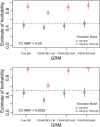Narrow-sense heritability estimation of complex traits using identity-by-descent information
- PMID: 29588506
- PMCID: PMC6221881
- DOI: 10.1038/s41437-018-0067-0
Narrow-sense heritability estimation of complex traits using identity-by-descent information
Abstract
Heritability is a fundamental parameter in genetics. Traditional estimates based on family or twin studies can be biased due to shared environmental or non-additive genetic variance. Alternatively, those based on genotyped or imputed variants typically underestimate narrow-sense heritability contributed by rare or otherwise poorly tagged causal variants. Identical-by-descent (IBD) segments of the genome share all variants between pairs of chromosomes except new mutations that have arisen since the last common ancestor. Therefore, relating phenotypic similarity to degree of IBD sharing among classically unrelated individuals is an appealing approach to estimating the near full additive genetic variance while possibly avoiding biases that can occur when modeling close relatives. We applied an IBD-based approach (GREML-IBD) to estimate heritability in unrelated individuals using phenotypic simulation with thousands of whole-genome sequences across a range of stratification, polygenicity levels, and the minor allele frequencies of causal variants (CVs). In simulations, the IBD-based approach produced unbiased heritability estimates, even when CVs were extremely rare, although precision was low. However, population stratification and non-genetic familial environmental effects shared across generations led to strong biases in IBD-based heritability. We used data on two traits in ~120,000 people from the UK Biobank to demonstrate that, depending on the trait and possible confounding environmental effects, GREML-IBD can be applied to very large genetic datasets to infer the contribution of very rare variants lost using other methods. However, we observed apparent biases in these real data, suggesting that more work may be required to understand and mitigate factors that influence IBD-based heritability estimates.
Conflict of interest statement
The authors declare that they have no conflict of interest.
Figures





References
-
- Bhatia G, Gusev A, Loh P-R, Finucane HK, Vilhjalmsson BJ, Ripke S et al. (2016). Subtle stratification confounds estimates of heritability from rare variants. bioRxiv. https://doi.org/10.1101/048181.
Publication types
MeSH terms
Grants and funding
LinkOut - more resources
Full Text Sources
Other Literature Sources

